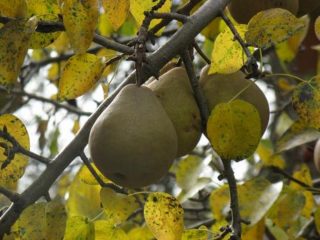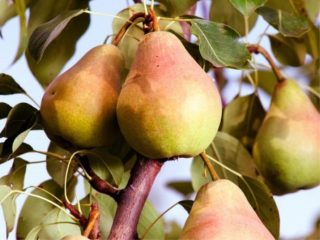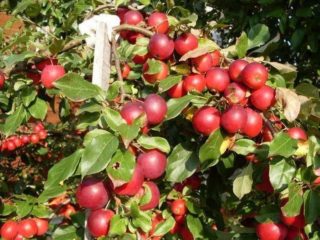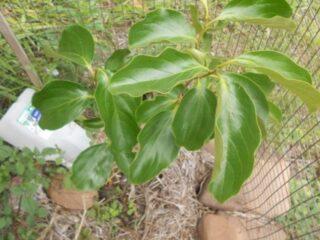Content
- 1 Description of the Caucasian medlar with a photo
- 2 Medlar composition and calorie content
- 3 The medicinal properties of the Caucasian medlar
- 4 The taste of the Caucasian medlar
- 5 How to eat the Caucasian medlar
- 6 The use of medlar in traditional medicine
- 7 Harm of the Caucasian medlar and contraindications
- 8 Growing Caucasian medlar at home
- 9 When the Caucasian medlar ripens
- 10 Conclusion
Caucasian medlar (Mespilus Caucasei) is a tree with unusual fruits that naturally grows on mountain slopes, in copses and oak forests. Its fruits contain many trace elements and vitamins, are of great benefit to patients with hypertension, asthma and diabetes. With regular use, medlar can cleanse the liver and blood vessels, improve digestion.
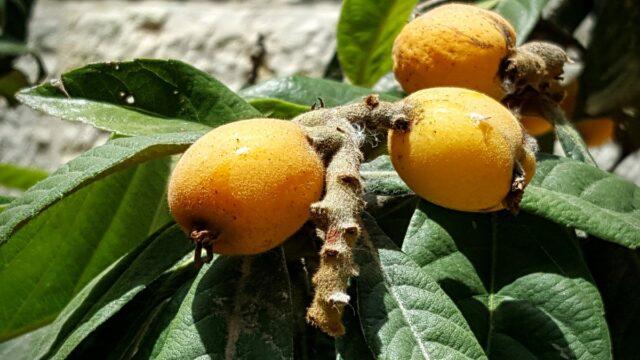
Caucasian medlar helps to remove harmful substances from the body, saturates it with vitamins
Description of the Caucasian medlar with a photo
Caucasian medlar is a fruit of the Rosaceae family, native to Eastern Europe and Western Asia. It can be found in Abkhazia, Crimea, Georgia and other countries with a favorable subtropical climate. The culture needs warm winters and summers, high air humidity. In the Caucasus, it grows both a wild and a garden plant.
The Caucasian medlar, or, as some call it, Abkhazian, is a medium-sized round-shaped fruit, slightly flattened on the sides. In appearance, they resemble small apples, on the outside they are covered with a fluffy formation. The color of the medlar is brown, with a slight red tint, diameter up to 3 cm, weight up to 8 g. Most of the volume of the fruit is occupied by inedible bones (seeds), which can contain up to seven pieces. The taste of the fruit is pleasant, slightly astringent, sweet and sour. Ripening occurs towards the end of summer or autumn, the period completely depends on the place of growth. Some people collect the fruits of the Caucasian medlar even in December.
The plant is a large, tall tree with a spreading crown, capable of reaching eight meters in height. Its trunk is not very voluminous, up to 20 cm in diameter. The leaves are large, wide, leathery, green in color, their surface is glossy, and the bottom is velvety, the edges are serrated. With the arrival of autumn, they begin to turn yellow and fall off. The foliage of the Caucasian medlar, as well as the fruits, contains useful substances; decoctions are prepared from it that help to cope with asthma and bronchitis. The plant blooms in spring with beautiful large buds of cream and white color, with a pleasant delicate aroma. The culture can be grown as a garden decoration or as a houseplant, but in this case, it needs to create conditions close to its natural environment. When grown indoors, the Caucasian loquat is a lot of hassle.
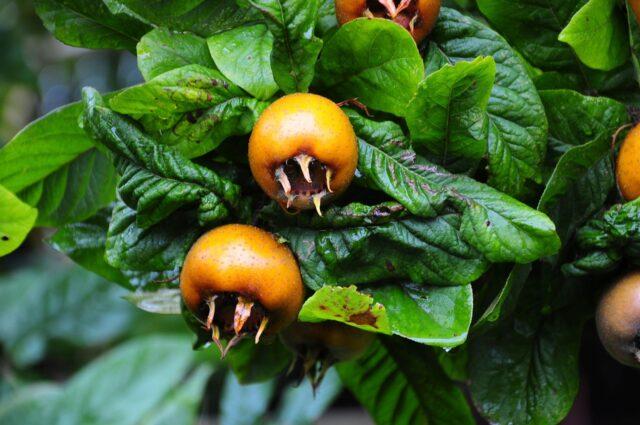
Decoctions are obtained from the leaves of this fruit tree to help with inflammatory diseases of the respiratory tract.
Medlar composition and calorie content
The Caucasian medlar is not just a beautiful culture with which you can decorate your backyard plot, but also a medicinal plant containing many useful substances. The fruits include:
- vitamins A, C, group B;
- minerals (potassium, magnesium, calcium);
- pectin;
- alimentary fiber;
- phytoncides;
- organic acids;
- polysaccharides;
- tannins.
100 g of the product contains 4% carbohydrates and 1% daily protein intake, there are no fats. The calorie content of the Caucasian medlar is 53 kcal.
The medicinal properties of the Caucasian medlar
Due to the very high content of ascorbic acid, the Caucasian medlar helps to strengthen the immune system, helps in the fight against infectious diseases, and increases the body's resistance to them. The fruits have a beneficial effect on the vascular system, prevent thrombosis. The tannins in the plant have a bactericidal effect. Berries are taken as an anti-inflammatory drug, a medicine to remove phlegm. In addition, they contribute to the normalization of blood circulation. Decoctions from the Caucasian variety of medlar have established themselves as a good hemostatic agent. The fruit helps to cleanse the body of toxins, stimulates intestinal peristalsis, improves the activity of the gastrointestinal tract and lowers blood cholesterol levels. The fruits of the plant have a positive effect on the condition of the muscles and the nervous system, normalize blood pressure, have a beneficial effect on the heart, improve blood clotting, which reduces the likelihood of stroke and heart attack. Due to the calcium content, Caucasian medlar strengthens bones, nails and hair. It is advised to include it in the diet of children and women carrying a child, since the ascorbic acid contained in the product helps to maintain immunity, and folic acid - the normal development of the embryo.
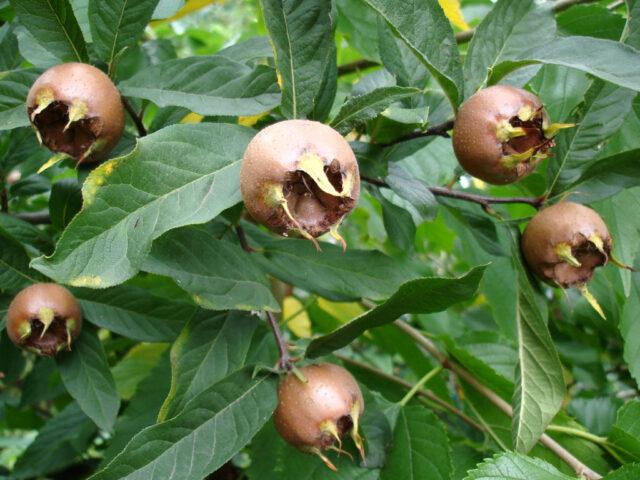
The fruits of culture are recommended for pregnant women and children.
The taste of the Caucasian medlar
The berries of the plant are aromatic, unusual, but pleasant to the taste, somewhat similar to quince and strawberries, have a slight sourness, the pulp is juicy. When fresh, they may have a slightly astringent flavor. If the harvest of the Caucasian medlar is harvested after frost, then the fruits become very sweet, without signs of acid.
How to eat the Caucasian medlar
Caucasian medlar is eaten both fresh and processed. Some housewives prepare compotes, syrups, jam, preserves from it and use berries as a decoration for desserts. To increase the shelf life, the fruits can be frozen. Leftover leftover fruit should be wrapped in paper and stored in the refrigerator.
Harvesting medlar is carried out after the berries acquire a softness and a reddish-brown hue. The culture cannot be transported; it can be stored in the refrigerator for no longer than two days.
Before eating the fruit, cut it into two parts, remove the seeds so as not to spoil the impression of the product, cut off the peel.
The use of medlar in traditional medicine
Caucasian medlar is actively used in folk medicine. From the fruits of the plant, tinctures and decoctions are prepared for the treatment of inflammation in the respiratory organs, the normalization of the gastrointestinal tract and digestion. To obtain the maximum effect in eliminating shortness of breath, cough, asthma symptoms, mashed Caucasian medlar mixed with natural honey is made.
It is known that ripe fruits of a culture have a laxative effect, while immature ones, on the contrary, have a fixing effect. A decoction of unripe berries helps with urolithiasis, restores the activity of the gastrointestinal tract.
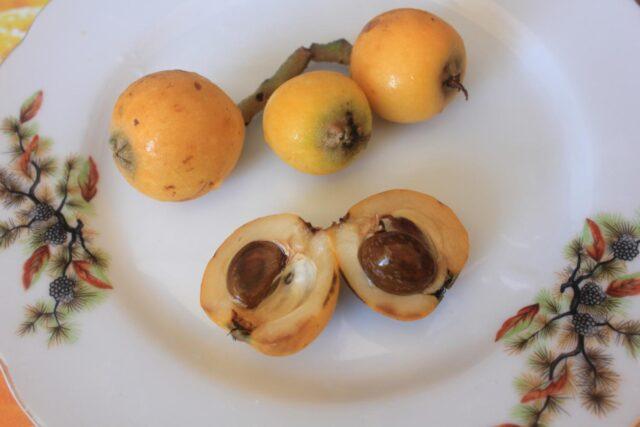
The fruit can have both a laxative and a fastening effect.
Harm of the Caucasian medlar and contraindications
Caucasian medlar mainly benefits people, but there are some contraindications in its use:
- Individual intolerance. Before you try the fruit, you should make sure that you are not allergic to it.
- Chronic stomach problems. People suffering from gastritis, ulcers, diseases of the pancreas need to use berries with caution so as not to cause an exacerbation.
- Violation of intestinal motility. The fruits of the plant are very tart, with a high content of tannins, and can cause constipation.
Growing Caucasian medlar at home
The Caucasian medlar is a plant that is very easy to grow on the site, although it is not very popular. This type of fruit tree does not need careful maintenance, it is combined with many cultures, it looks interesting in the landscape. In order for the medlar to grow well and bear fruit, it is enough to water and feed it periodically.
Landing
The Caucasian medlar is a tree that can be planted in spring or autumn. It all depends on the climatic conditions of the growing region. The plant prefers sunny areas, without strong wind and draft. Experts on agricultural technology argue that the culture is frost-resistant, but as practice shows, it does not tolerate severe cold. The Caucasian medlar does not impose special requirements on the composition of the soil, however, it feels best on slightly acidic and neutral soil. Humus, sandy loam and soddy soil with an acidity of 5-6 points is considered the most favorable for the growing season of culture.
If the Caucasian medlar is planted in the ground with seedlings, then this is done according to the following algorithm:
- The site for the plant is pre-freed from weeds, dug up, sprinkled with bone meal and mineral fertilizers.
- Dig a hole so that it is twice the size of the roots of the seedling.
- They put a peg in the hole, put a tree, sprinkle it with earth.
- Tie the seedling to the support.
- Sprinkle abundantly with warm water.
A couple of days after planting, the plant is mulched with rotted manure and compost.
When growing a tree from a bone, you should carefully prepare the planting material. Since the fruit seeds of the medlar have a dense shell, they are cut and soaked in water for 10-12 hours before planting. After that, the material is placed in fertile soil treated with boiling water, which is a mixture of ash, humus, sand and peat. It is necessary to deepen the seed by 4-5 cm. The sprout of the Caucasian medlar should appear a month and a half after planting the seed. For two years, the usual care is carried out for him, then planted in a permanent place.
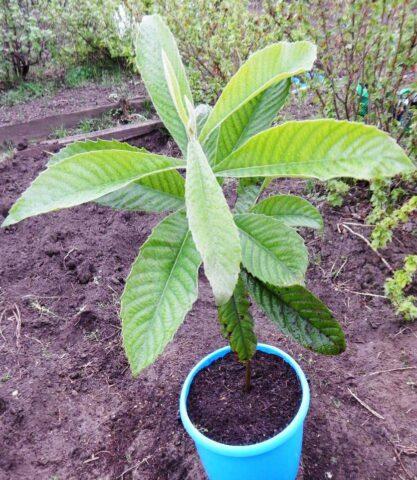
To make the tree grow even and beautiful, its seedling is tied to a peg
Care
When caring for the Caucasian variety of medlar, there are no special difficulties. The culture requires moderate watering, stagnation of moisture in the near-stem circle should be avoided. The tree responds favorably to fertilizing with organic fertilizers with mullein (ratio 8: 1). It is advisable to feed young specimens and seedlings once a month, adults - twice a season. To form the crown, it is advisable to prune the tree; the procedure is also necessary for sanitary purposes. Sick, damaged, dry branches of the crop should be removed regularly, the yield and health of the plant depend on it. In the spring, it is advisable to cut off frozen, as well as unpromising shoots.
Reproduction
In the Caucasus, the plant can often be found on the streets, in vegetable gardens and orchards. The culture is great for landscaping areas. It is propagated most often by cuttings or seeds, less often by layering.
In the first case, gardeners cut off the offshoot of an adult fruit tree, remove half of the foliage from it and keep it in water for half a day. After that, the cut site is treated with ash and planted on the site. Cuttings are usually taken 1.5-2 months after planting.
In the second case, the seeds of ripe fruits are cut into two parts, soaked in water, and then planted in a container filled with fertile soil mixture. A year later, the sprout is transplanted into a pot with a larger diameter, after the same amount of time, it is planted in a permanent place.
Some gardeners, with the onset of autumn, bend the stem of the tree to the soil, make an incision in it and cover it with foil. With the arrival of warm spring days, the shelter is removed, if the shoot from the incision has taken root, it is transplanted.
When the Caucasian medlar ripens
Fruiting of the culture begins three to five years after planting. In a favorable climate, the fruit fully ripens closer to August. If the summer is cool, then the collection of berries is postponed until the onset of the autumn season - in the second half of September.

In warm sunny weather, the Caucasian medlar ripens very quickly.
Conclusion
The Caucasian medlar is a little-known exotic fruit that grows in a subtropical climate. The plant is unpretentious, it looks interesting in landscape design. Its fruits have beneficial properties for health, strengthen immunity well, and help fight various diseases. Decoctions from medlar are often used in folk medicine to get rid of various ailments. The berries have a pleasant taste and can be used in cooking.




